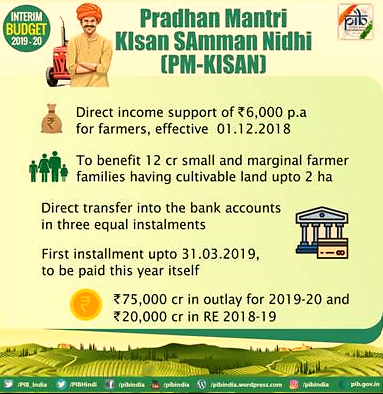One Year Of PM-KISAN Scheme
- 26 Feb 2020
- Pradhan Mantri Kisan Samman Nidhi, popularly known as (PM-KISAN) scheme completed one year on 24th February, 2020.
- The scheme was launched by the government on 24th February, 2019, in Gorakhpur district, Uttar Pradesh.
About PM-KISAN Scheme
- PM-KISAN is a Central Sector scheme with 100% funding from Government of India with an aim to increase the income of farmers by offering income support to all landholding farmers’ families across India.
- The Scheme is effective from 1st December, 2018.
- Under the Scheme an amount of Rs.6000/- per year is transferred in three 4-monthly installments of Rs. 2000/- directly into the bank accounts of the farmers, subject to certain exclusion criteria relating to higher income status.
- The financial benefits are released to the beneficiaries on the basis of the data of farmers prepared and uploaded by them on the PM-Kisan web-portal.
- At present, all states except West Bengal are implementing the scheme.
Eligibility Criteria
- It initially provided income support to all Small and Marginal Farmer’s (SMF) families across the country, holding cultivable land upto 2 hectares.
- Later, its ambit was expanded e.f. 1st June, 2019 to cover all farmer families in the country irrespective of the size of their land holdings.
Exceptions
- Affluent farmers have been excluded from the scheme such asIIncome Tax payers in last assessment year, professionals like Doctors, Engineers, Lawyers, Chartered Accountants, etc. and pensioners drawing at least Rs.10,000/- per month (excluding Multi Tasking Staff (MTS)/Class IV/Group D employees).
- Special provisions have been made for the North-Eastern States where land ownership rights are community based, Forest Dwellers, and Jharkhand, which does not have updated land records and restrictions on transfer of land.
Progress So Far
- The Central Government has already released more than Rs. 50850 crores till now.
- Total number of beneficiaries to be covered under the scheme is about 14 crore, based on estimates of the Agriculture Census 2015-16.
- As on 20th February 2020, farmer families of 8.46 crores have been given the benefits.
Significance
- The significance of PM-KISAN is that, for the first time, an attempt has been made to transfer income directly to farmers without using price policy (of either inputs or output).
- In most of the programmes in the past, the policy instrument used has always been price.
Advantages
- The main advantage is that the benefits are not linked to production of any crop. And since the benefits are not linked to production, the resultant supply-demand imbalance is expected to be minimal, unlike in the case of minimum support prices (MSPs).
- Also, there is no need of procurement, storage and distribution of all the commodities. Instead, procurement can be limited to only those commodities that are needed for public distribution system. This should lead to much lower fiscal costs and lesser storage infrastructure.
Issues with PM-KISAN
Implementation Issue
- In India, majority of the States have incomplete tenancy records and land data are not digitized.
- For example, Bihar has registered only one third of its farmers because of lack of digital data. Madhya Pradesh, Rajasthan, Maharashtra, Andhra Pradesh and Karnataka have identified 55-60% of their farmers as beneficiaries while Chhattisgarh has verified less than half of its farmers. Uttar Pradesh has verified 85% of the 25 million farmers it has, as per the agricultural census of 2016, while Rajasthan has registered 80% of its farmers.
Difficulty in Identifying Beneficiary Farmers
- According to agricultural census of 2015-16, number of landholdings in the country was projected at Rs 14.65 crore. But, landholdings do not determine the number of farmer families present in the country, as there are multiple owners for a single land. In such scenario, all the farmer families which own the land are eligible for the scheme.
- It may also happen that a single farmer holds multiple lands. The agricultural census may record multiple landholdings which PM-Kisan scheme would otherwise recognise as single farmer.
Infrastructure Issues
- PM-KISAN payments have to be direct bank transfers. This involves, inter alia, two big problems: (i) lack of last-mile banking connectivity in the country and (ii) possibility of banks offsetting the transferred amount to settle outstanding loans of the beneficiary, leaving the beneficiary high and dry.
Way Forward
- PM-KISAN is an ambitious scheme that has the potential to deliver significant welfare outcomes. However, the current top-down, rushed approach of the government ignores governance constraints and is therefore likely to result in failure.
- An alternative bottom-up strategy and well-planned implementation mechanism would allow weaknesses to be identified and rectified at the local level. The most effective modalities can then be scaled nationally ensuring success.
- Despite the initial challenges, the scheme can pave the way for a slew of fresh measures in near future to support the farm sector and help to achieve the target of doubling farmers’ income by the year 2022.


